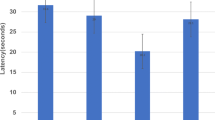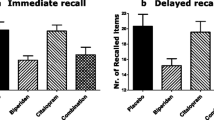Abstract
Rationale
Enhancement of histaminergic neurotransmission or histaminergic plus cholinergic neurotransmission may represent novel strategies for improving cognition in Alzheimer's disease.
Objective
To evaluate the effects of a novel histamine H3 receptor inverse agonist (MK-3134), an acetylcholinesterase inhibitor (donepezil), and their combination in attenuating the cognitive impairment associated with scopolamine.
Methods
Thirty-one subjects were randomized, and 28 completed this double-blind, placebo-controlled, five-period crossover study. Cognition was assessed using the Groton Maze Learning Task (GMLT) as the primary outcome measure. The two primary hypotheses were that donepezil 10 mg and MK-3134 25 mg, respectively, would attenuate scopolamine (0.5 mg)-induced impairment as measured by the GMLT over the first 12 h after scopolamine administration (AUC1–12 h). A secondary hypothesis was that the combination of donepezil and MK-3134 would attenuate scopolamine-induced cognitive impairment to a greater extent than either agent alone as measured by the GMLT AUC1–12 h.
Results
The primary and secondary hypotheses were not met. Upon examining the time course of the scopolamine effects (an exploratory objective), peak effects were generally observed around 2 h after scopolamine administration. Administration of MK-3134 or donepezil improved performance on the GMLT at the 2-h time point, rather than AUC1–12 h, compared with scopolamine alone. Moreover, it appeared that the combination of MK-3134 and donepezil blunted the scopolamine effect to a greater extent than either drug alone.
Conclusions
Exploratory analyses provide evidence for cognitive improvement through inverse agonism of the H3 histamine receptor and for cooperation between human cholinergic and histaminergic neurotransmitter systems.
(ClinicalTrials.gov trial registration number: NCT01181310)



Similar content being viewed by others
References
Alvarez EO (2009) The role of histamine on cognition. Behav Brain Res 199:183–189
Arrang JM, Garbarg M, Schwartz JC (1983) Auto-inhibition of brain histamine release medicated by a novel class (H3) of histamine receptor. Nature 302:832–837
Arrang JM, Drutel G, Schwartz JC (1995) Characterization of histamine H3 receptors regulating acetylcholine release in rat entorhinal cortex. Br J Pharmacol 114:1518–1522
Arrang JM, Morisset S, Gbahou F (2007) Constitutive activity of the histamine H3 receptor. Trends in Pharmacological Sciences 28:350–357
Bacciottini L, Passani MB, Mannaioni PF, Blandina P (2001) Interactions between histaminergic and cholinergic systems in learning and memory. Behavioral Brain Research 124:183–194
Basu R, Dodge H, Stoehr GP, Ganguli M (2003) Sedative-hypnotic use of diphenhydramine in a rural, older adult, community-based cohort—effects on cognition. American Journal of Geriatric Psychiatry 11:205–213
Blandina P, Efoudebe M, Cenni G, Mannaioni P, Passani MB (2004) Acetylcholine, histamine, and cognition: two sides of the same coin. Learning & Memory 11:1–8
Collie A, Maruff P, Snyder PJ, Darekar A, Huggins JP (2006) Cognitive testing in early phase clinical trials: outcome according to adverse event profile in a Phase I study. Human Psychopharmacology-Clinical and Experimental 21:481–488
Collie A, Darekar A, Weissgerber G, Toh MK, Snyder PJ, Maruff P et al (2007) Cognitive testing in early-phase clinical trials: development of a rapid computerized test battery and application in a simulated Phase I study. Contemporary Clinical Trials 28:391–400
Curran HV, Pooviboonsuk P, Dalton JA, Lader MH (1998) Differentiating the effects of centrally acting drugs on arousal and memory: an event-related potential study of scopolamine, lorazepam and diphenhydramine. Psychopharmacology (Berl) 135:27–36
Ebert U, Siepmann M, Oertel R, Wesnes KA, Kirch W (1998) Pharmacokinetics and pharmacodynamics of scopolamine after subcutaneous administration. Journal of Clinical Pharmacology 38:720–726
Edginton T, Rusted JM (2003) Separate and combined effects of scopolamine and nicotine on retrieval-induced forgetting. Psychopharmacology 170:351–357
Ellis JR, Ellis KA, Bartholomeusz CF, Harrison BJ, Wesnes KA, Erskine FF et al (2006) Muscarinic and nicotinic receptors synergistically modulate working memory and attention in humans. International Journal of Neuropsychopharmacology 9:175–189
Esbenshade TA, Browman KE, Bitner RS, Strakhova M, Cowart MD, Brioni JD (2008) The histamine H-3 receptor: an attractive target for the treatment of cognitive disorders. Br J Pharmacol 154:1166–1181
Falleti MG, Maruff P, Collie A, Darby DG (2006) Practice effects associated with the repeated assessment of cognitive function using the CogState battery at 10-minute, one week and one month test–retest intervals. Journal of Clinical and Experimental Neuropsychology 28:1095–1112
Fernandez-Novoa L, Cacabelos R (2001) Histamine function in brain disorders. Behavioural Brain Research 124:213–233
Fredrickson A, Snyder PJ, Cromer J, Thomas E, Lewis M, Maruff P (2008) The use of effect sizes to characterize the nature of cognitive change in psychopharmacological studies: an example with scopolamine. Hum Psychopharmacol 23:425–436
Haas H, Panula P (2003) The role of histamine and the tuberomammillary nucleus in the nervous system. Nature Reviews Neuroscience 4:121–130
Huff FJ, Mickel SF, Corkin S, Growdon JH (1988) Cognitive functions affected by scopolamine in Alzheimer's disease and normal aging. Drug Development Research 12:271–278
Kopelman MD, Corn TH (1988) Cholinergic blockade as a model for cholinergic depletion—a comparison of the memory deficits with those of Alzheimer-type dementia and the alcoholic Korsakoff syndrome. Brain 111:1079–1110
Martorana A, Esposito Z, Koch G (2010) Beyond the cholinergic hypothesis: do current drugs work in Alzheimer's disease? CNS Neuroscience and Therapeutics 16:235–245
Mihara M, Ohnishi A, Tomono Y, Hasegawa J, Shimamura Y, Yamazaki K, Morishita N (1993) Pharmacokinetics of E2020, a new compound for Alzheimer's disease, in healthy male volunteers. Int J Clin Pharmacol Ther Toxicol 31:223–229
Nagase T, Mizutani T, Sekino E, Ishikawa S, Ito S, Mitobe Y et al (2008) Synthesis and evaluation of structurally constrained quinazolinone derivatives as potent and selective histamine H-3 receptor inverse agonists. Journal of Medicinal Chemistry 51:6889–6901
Orsetti M, Ghi P, Di Carlo G (2001) Histamine H(3)-receptor antagonism improves memory retention and reverses the cognitive deficit induced by scopolamine in a two-trial place recognition task. Behav Brain Res 124:235–242
Parrott AC (1986) The effects of transdermal scopolamine and 4 dose levels of oral scopolamine (0.15, 0.3, 0.6, and 1.2 mg) upon psychological performance. Psychopharmacology 89:347–354
Parsons ME, Ganellin CR (2006) Histamine and its receptors. Br J Pharmacol 147:S127–S135
Passani MB, Bacciottini L, Mannaioni PF, Blandina P (2000) Central histaminergic system and cognition. Neuroscience and Biobehavioral Reviews 24:107–113
Passani MB, Cangioli L, Baldi E, Bucherelli C, Mannaioni PF, Blandina P (2001) Histamine H-3 receptor-mediated impairment of contextual fear conditioning and in-vivo inhibition of cholinergic transmission in the rat basolateral amygdala. European Journal of Neuroscience 14:1522–1532
Passani MB, Lin JS, Hancock A, Crochet S, Blandina P (2004) The histamine H-3 receptor as a novel therapeutic target for cognitive and sleep disorders. Trends in Pharmacological Sciences 25:618–625
Pietrzak RH, Maruff P, Mayes LC, Roman SA, Sosa JA, Snyder PJ (2008) An examination of the construct validity and factor structure of the Groton Maze Learning Test, a new measure of spatial working memory, learning efficiency, and error monitoring. Archives of Clinical Neuropsychology 23:433–445
Roman GC, Rogers SJ (2004) Donepezil: a clinical review of current and emerging indications. Expert Opinion on Pharmacotherapy 5:161–180
Sander K, Kottke T, Stark H (2008) Histamine H-3 receptor antagonists go to clinics. Biological & Pharmaceutical Bulletin 31:2163–2181
Sarter M, Bruno JP (2004) Developmental origins of the age-related decline in cortical cholinergic function and associated cognitive abilities. Neurobiology of Aging 25:1127–1139
Snyder PJ, Bednar MM, Cromer JR, Maruff P (2005a) Reversal of scopolamine-induced deficits with a single dose of donepezil, an acetylcholinesterase inhibitor. Alzheimers Dement 1:126–135
Snyder PJ, Werth J, Giordani B, Caveney AF, Feltner D, Maruff P (2005b) A method for determining the magnitude of change across different cognitive functions in clinical trials: the effects of acute administration of two different doses alprazolam. Human Psychopharmacology-Clinical and Experimental 20:263–273
Stocking EM, Letavic MA (2008) Histamine H-3 antagonists as wake-promoting and pro-cognitive agents. Current Topics in Medicinal Chemistry 8:988–1002
Tariot PN, Patel SV, Cox C, Henderson RE (1996) Age-related decline in central cholinergic function demonstrated with scopolamine. Psychopharmacology 125:50–56
Thomas E, Snyder PJ, Pietrzak RH, Jackson CE, Bednar M, Maruff P (2008) Specific impairments in visuospatial working and short-term memory following low-dose scopolamine challenge in healthy older adults. Neuropsychologia 46:2476–2484
Van Ruitenbeek P, Vermeeren A, Riedel WJ (2010) Cognitive domains affected by histamine H(1)-antagonism in humans: a literature review. Brain Res Rev 64:263–282
Wesnes K, Simpson P, Kidd A (1988) An investigation of the range of cognitive impairments induced by scopolamine 0.6 mg s.c. Human Psychopharmacology 3:27–41
Witkin JM, Nelson DL (2004) Selective histamine H3 receptor antagonists for treatment of cognitive deficiencies and other disorders of the central nervous system. Pharmacology and Therapeutics 103:1–20
Acknowledgements
The authors thank Gertrude Noonan from Merck for assistance in drafting and editing the manuscript and to Sheila Erespe from Merck for assistance in formatting. The experiments complied with the current laws of the country in which they were performed.
Financial disclosures
W Cho, C Gargano, N Calder, S Doran, S Fox-Bosetti, A Hassan, J Renger, G Herman, C Lines, and A Verma are or were employees of Merck Sharp & Dohme Corp., a subsidiary of Merck & Co., Inc., who may own stock and/or hold stock options in the company. J Connell had received research funding from Merck. P Maruff is a full-time employee of CogState, the company that provided the cognitive assessment tools used in this study.
Funding
The study was funded by Merck Sharp & Dohme Corp, a subsidiary of Merck & Co., Inc.
Author information
Authors and Affiliations
Corresponding author
Rights and permissions
About this article
Cite this article
Cho, W., Maruff, P., Connell, J. et al. Additive effects of a cholinesterase inhibitor and a histamine inverse agonist on scopolamine deficits in humans. Psychopharmacology 218, 513–524 (2011). https://doi.org/10.1007/s00213-011-2344-y
Received:
Accepted:
Published:
Issue Date:
DOI: https://doi.org/10.1007/s00213-011-2344-y




